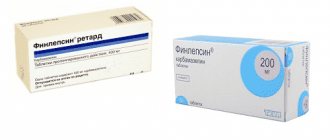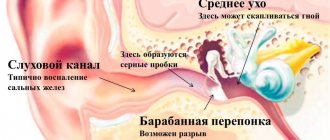Why are my ears clogged?
The main criterion for the appearance of congestion is hearing impairment. Sometimes there is a feeling of the presence of a foreign object in the ear canals. Some people experience background noise in their heads and experience dizziness.
The external organs of hearing, despite their small size, have a complex structure. There are external (auricle), middle, and inner ears. The pharynx is connected to the middle ear by the Eustachian tubes.
Table. Causes of stuffy ears:
| Name of the provoking factor | Priority symptoms |
| Atmospheric pressure difference | There is noticeable pressure on the eardrum with pain and hearing loss, often on an airplane when it takes off or lands. Identical manifestations are typical when you are in a moving elevator, at depth, or while driving fast. |
| Sulfur plugs | Ears become clogged if wax builds up in the ear canal. If you do not take timely measures to eliminate it, you can completely lose your hearing for a short time. |
| Water in the ear | When immersed in water, there is a danger of liquid penetrating into the depths of the ear canal. If it does not pour out completely, the person experiences a disturbing and unpleasant feeling of heaviness in the ear area. |
| Consequences of otitis media | Congestion can be caused by previous otitis media. Due to the inflammatory process, adhesions form on the eardrum, limiting the normal functioning of the hearing aid. |
| Sensorineural hearing loss | There is a noticeable deterioration in hearing with a feeling of the presence of a constant pressure plug in the passages due to a lack of blood supply that occurs after damage to the auditory nerve. This condition is observed with arterial hypertension, cerebral ischemia, and head injuries. |
| Eustachite | Sometimes the ears become clogged as a result of an inflammatory process inside the auditory tube. |
| Allergic rhinitis | People who experience frequent allergic reactions to various irritants may experience swelling of the nasal mucosa. The development of an allergic rhinitis results in noticeable stuffiness in the ears. |
| Vegetative-vascular dystonia | Sharp fluctuations in blood pressure, which provoke a feeling of congestion, often occur as a result of hormonal changes during pregnancy, menopause, and also in adolescents. |
| Crooked ear canal | The constantly haunting feeling of ear fullness may be due to anatomical features, for example, curvature or noticeable narrowing of the ear canal. |
| Sinusitis | Sometimes in one ear or on both sides at once, the sensation of the appearance of a foreign object, an annoying hum, or a blockage indicates the development of sinusitis. This pathology causes severe headaches and a sharp deterioration in general condition. |
| Tonsillitis | Sometimes, if, for example, the left ear begins to clog, it can be stated that inflammation in the throat area begins to develop on this side. The corresponding conclusion can be drawn if a feeling of pressure occurs from the right ear. |
| Cervical osteochondrosis | The cause of sudden numbness of a part of the face, the appearance of a severe headache, and sudden swelling of the ears may be cervical osteochondrosis. This manifestation is usually associated with pinched nerves or narrowing of blood vessels. |
| Migraine | Migraine attacks are accompanied not only by severe headache, throbbing in the temples, darkening of the eyes, but also by tinnitus and a feeling of congestion. This is due to the narrowing and subsequent expansion of the arteries. |
There are many factors that lead to a feeling of fullness in the ears. At the same time, sensations of noise, ringing, and pressure cause discomfort. They have varying degrees of severity.
If a person realizes that he has difficulty hearing and feels an incomprehensible noise in his head, he should not panic, since these symptoms do not always serve as a harbinger of serious illnesses.
Be sure to identify, if your ears are often blocked, the reasons for the feeling of pressure on the eardrum. This approach allows you to select the optimal methods. They allow you to effectively relieve unpleasant symptoms.
Sore throat often occurs with various viral diseases of the respiratory system. To reduce pain and discomfort, sprays, syrups and tablets are used, some of which contain an antibiotic to suppress pathogens. Read more in the article: “antibiotic throat tablets.”
How to distinguish normal congestion from disease?
Short-term congestion and tinnitus may appear during a cold, but they most often go away on their own after other symptoms have resolved. However, there are infectious diseases that occur directly in the auditory tube or middle ear. You can understand that additional treatment for ear congestion is necessary by the following signs:
- cold symptoms go away, but ears still bother you,
- Ear congestion persists for a long time and is accompanied by pain,
- Changing positions and slow exhalations of air do not help,
- there is a decrease in hearing acuity,
- discharge appears from the ear canal,
- congestion is accompanied by dizziness.
What to do in case of sulfur plug?
Advertising:
A small wax plug that has not yet had time to compress can be removed at home on your own. Proper selection of medications speeds up recovery. This will be useful when organizing therapeutic measures to eliminate the problem.
Many representatives of the fairer sex are well aware of such a delicate problem as vaginal candidiasis. This disease, which many prefer to bashfully remain silent about, can turn a woman’s life into a continuous strip of problems and obstacles. Read more in the article: “causes and treatment of thrush in women.”
It is recommended to use pharmacy hydrogen peroxide with a concentration of 3%. Inject 5-6 drops into the ear. As a result of the reaction, the cork softens. The outer ear, after the foam comes out along with the dirt, is washed with warm water.
Oil softens cork well - almond, olive, sunflower. It is slightly warmed and then inserted into the ear using a pipette. After 8-10 minutes, fill a small syringe with warm water and gently rinse the ear canal.
A dense plug that causes almost complete hearing loss with severe congestion should be removed in a medical facility.
A qualified doctor will perform the procedure using the necessary equipment. If necessary, an examination will be carried out. To relieve accompanying inflammation, medications are usually prescribed.
Stuffed ear. Actions for a stuffy ear
Why is my ear stuffy?
The human ear is one of the main human sense organs.
With the help of the ear, we hear the sounds around us, enjoy music, perceive human speech, which is of great importance both for the subject and for the development of the entire human society. The physiology and anatomy of the human ear is aimed at capturing sound vibrations in the air and converting them into an electrical signal in the form of a nerve impulse, which is analyzed in the auditory center of the cerebral cortex. Any of the ear diseases leads to hearing loss, which is always accompanied by a feeling like a stuffy ear or stuffy ears. The human ear is anatomically divided into three sections. The outer ear is represented by the auricle and the auditory canal. The middle ear is represented by the tympanic cavity, in which the auditory ossicles are located, the tympanic cavity is limited on the side of the auditory canal by the eardrum. The inner ear is located deep in the temporal bone and consists of the auditory cochlea and the semicircular canals of the vestibular analyzer.
With diseases of any part of the ear, to one degree or another, it seems that the ear is blocked. Diseases such as tubootitis, acute purulent otitis media, otitis externa are the result of inflammatory phenomena in the ear and are always accompanied by a feeling that the ear is stuffy. Very often, as a result of improper toileting of the external auditory canal, sulfur can accumulate in it, forming a cerumen plug, which will also be accompanied by ear congestion. Due to the peculiarities of the blood supply to the inner ear, sometimes it can be disrupted, which leads to insufficient oxygen supply to the auditory nerve, which will also be accompanied by hearing loss and ear congestion; this pathology is called sensorineural hearing loss.
Very often, pregnant women turn to an ENT doctor with a complaint that the ear is blocked; this is due to hormonal changes in the woman’s body, as a result of which swelling of the nasal mucosa occurs, which is accompanied by dysfunction of the auditory tube (tubo-otitis), and with tubo-otitis the ear is always blocked. This condition during pregnancy is called rhinosinusopathy of pregnancy, as a rule, after childbirth resolves, ear congestion goes away.
Possible complications of ear congestion
Ear congestion is a consequence of a disease in any part of the ear. To establish the cause of the feeling that the ear is blocked, you need to examine the eardrum, which is what the ENT doctor does during otoscopy. In some cases, it is necessary to perform an additional study - pure tone threshold audiometry. Sometimes an ear disease requires immediate treatment, and the preservation of your hearing will depend on this.
Very often, experiencing a feeling of ear congestion, the patient is in no hurry to visit an ENT doctor, thinking that he has a cerumen plug. And ear congestion can be a symptom of sensorineural hearing loss requiring emergency vascular therapy. The fact is that sensorineural hearing loss has a good prognosis if treated in the shortest possible time from the onset of the disease. Therefore, if such a patient does not consult an ENT doctor in a timely manner, he may not have time to preserve his hearing, which will lead to permanent hearing loss, sometimes even to deafness. Therefore, if you have a stuffy ear, it is better to visit an ENT doctor as soon as possible to determine the exact cause of this symptom and receive the correct recommendations for treating this condition. Even if you are sure that you have cerumen, do not self-medicate, but visit an ENT doctor, deafness is too high a price that it is better not to pay for self-medication.
My ear is blocked, what should I do?
The slightest inflammatory phenomena in the middle ear are accompanied by impaired mobility of the auditory ossicles, which leads to a sensation such as ear congestion. A common cold very often manifests itself as rhinitis, which can lead to swelling of the mouths of the auditory tubes, causing its dysfunction, in which the ear is always blocked. In such cases, treatment at home using ear drops and a blue lamp can give a good result, stopping the progression of the disease.
But, unfortunately, treatment of ear congestion at home is often not effective. If the cause of ear congestion is a consequence of inflammation of the skin of the external auditory canal, ear drops will be useless, and warming the ear with a blue lamp will only worsen the disease. To quickly relieve ear congestion, it is necessary to accurately identify the cause of this condition, which is possible only after examination by a qualified ENT doctor.
Treatment of ear congestion
In our center, ear congestion is effectively treated, no matter what part of the ear it is associated with. If this is inflammation of the skin of the ear canal, then photodynamic therapy quickly relieves inflammation of the skin of a bacterial and fungal nature. In case of inflammation of the middle ear, tubo-otitis, the mucous membrane of the nasopharynx is sanitized using mineral therapy, which leads to the rapid restoration of the function of the auditory tube and ear congestion goes away in the shortest possible time. If you have a blocked ear, do not self-medicate; by contacting our clinic in a timely manner, you can avoid a number of unpleasant complications and, most importantly, maintain good hearing.
Application of Remo Wax for traffic jams
To remove excess sulfur, special drops are used, for example, Remo Vax. This product quickly dissolves contaminants, softens irritated membranes of the ear canal, having a calming effect on them.
Advertising:
A child less than a year old can be treated for wax accumulation with Remo Vax. Can be used by nursing and pregnant women. Suitable for older people. The following algorithm of actions is observed:
- Before use, you must lie on your side. A thick cloth napkin is immediately placed on the bottom of the pillow.
- The product should be at room temperature.
- Gently pour along the wall of the ear canal so that the medicine fills it completely.
- After 10 minutes they turn over. Allow the darkened product to flow onto a specially pre-placed napkin.
- If necessary, repeat on the other side.
Such sessions are performed no more than once every 14 days. If it is necessary to remove a dense sulfur plug, then increase the duration of exposure of the drug to 30 minutes. There is no need to rinse or clean the ear canals so as not to reduce the therapeutic effect of the drug.
Elimination of congestion in otitis media
It is recommended to use remedies from the field of alternative medicine only at the initial signs. They usually indicate the development of otitis media in the form of mild congestion. At the same time, mild pain in the ear canal is often observed.
Warming compresses will help with otitis media, but their use is possible in the absence of severe inflammatory or purulent processes.
For the procedure, take gauze folded in 4-5 layers. It is soaked in camphor alcohol and applied directly to the auricle. Cover with cotton wool. Can be secured with a scarf. Leave this compress for 20 minutes. Practice every eight hours.
Advertising:
For complicated manifestations of otitis media, it is necessary to use medications prescribed by the doctor. Depending on the causative agent of the disease, antibiotics or antifungal drugs are used.
You will need vitamins, as well as drops to help relieve the inflammatory process. The drug Otipax is used successfully for congestion. Garazon antibacterial drops help. Otinum drops have an analgesic and antimicrobial effect. They are also able to remove sulfur plugs, since they have a softening effect on them.
Treatment of ear diseases
When the underlying condition has been treated, and the congestion and noise in the ears does not go away, the doctor will conduct an additional examination of the hearing aid. These are visual examination and special instrumental diagnostic methods. Depending on the cause of the pathology, medications and treatment procedures will be prescribed. After completing a therapeutic course, in most cases, ear congestion goes away without consequences for the patient. A timely visit to a specialist will help prevent complications.
You can consult about the causes of ear congestion and make an appointment with a specialist by calling our clinic or using the form on the website.
FIND OUT PRICES
How to act in case of pressure changes?
Very often the ears become blocked due to a sharp rise or fall. This manifestation is due to fluctuations in atmospheric pressure. To relieve the pressing sensation, no special treatment techniques are required. If such a situation arises, then you must:
- put candy in your mouth and suck it;
- chew gum vigorously;
- make a deep yawn;
- alternately open and close your mouth widely.
Another effective method is recommended. You need to completely pinch your nose with your fingertips and blow air out of yourself to feel a popping sensation in the ear area. After this, swallowing movements are made several times.
It is more difficult to cope with painful migraine attacks. There are practically no effective drugs for this disease. To reduce congestion, eliminate background noise, and cope with unbearable pain, it is recommended to perform a massage, directing movements from the forehead towards the back of the head.
You can apply slices of fresh lemon fruit to your temples. To eliminate pain, dissolve 1 tbsp. l. in 200 ml of cool water. Soak a linen towel in saline solution, wrap it tightly around your head and lie down in a darkened room, avoiding noise.
At what pressure do ear clogs most often occur: high or low?
Ear congestion is disproportionately more common in patients with high blood pressure.
This symptom is more common in patients with complicated hypertension (frequent crises, hypertensive encephalopathy), a combination of hypertension with widespread atherosclerosis, and osteochondrosis of the cervical spine.
The pathogenetic basis of atherosclerosis is the deposition of cholesterol plaques on the vascular walls, which narrow the lumen and slow down blood flow (including to the auditory analyzer). Hypoxia affects all structures of the brain and, in addition to congestion, the patient complains of hearing loss, memory loss, dizziness, and vision problems.
With osteochondrosis, the outflow from the venous sinuses becomes difficult, which increases intracranial pressure. In combination with changes in blood pressure, this causes stuffy ears. Additionally, patients may complain of dull, arching pain in the back of the head, neck, and a crunching sound when turning or tilting the head.
Hypotension
The phenomena of arterial hypotension predominantly accompany VSD of the hypokinetic type (with a predominance of parasympathetic stimulation).
The cause of ear congestion is a slowdown in the outflow of blood through the veins due to a violation of autoregulation of the tone of the vascular wall, which provokes an increase in intracranial pressure.
Additional signs of hypotension:
- Loss of strength, chronic fatigue, drowsiness;
- Weakened concentration and memory;
- Meteosensitivity;
- Visual disturbances (dark spots, spots before the eyes) due to orthostatic hypotension;
- Tendency to depression, apathy.
Hypertension
Hypertension is a sustained increase in pressure (systolic and/or diastolic) caused by the predominance of pressor mechanisms and insufficiency of depressor reactions, which is accompanied by secondary pathology of target organs (heart, brain, kidneys, retina).
With high blood pressure, the ears become blocked due to:
- The influence of pathological impulses of the hypothalamus, resulting from stress, on the sympathetic plexuses of the vascular wall, which enhance the motor component of arteriolar tone;
- Renal factor is the synthesis of angiotensin II by the juxtaglomerular apparatus of the kidneys in response to vasoconstriction, which causes even greater spasm of blood vessels, accumulation of sodium and fluid in their walls, which leads to swelling and narrowing of the lumen of arterioles.
Congestion in the ears due to spasm of cerebral arterioles may be the first symptom to suspect arterial hypertension.
The following signs are added:
- Vertigo, nausea, insomnia;
- Pathognomonic headaches - dull, bursting headaches in the back of the head, temples, mainly in the morning;
- Noise in ears;
- Edema of the lower extremities;
- Visual impairment (double vision, spots);
- Discomfort in the pericardial region;
- Numbness in the arms or legs.
If a patient feels dizzy and has stuffy ears due to high blood pressure, a serious complication is likely to develop - hypertensive encephalopathy.
Relieving congestion when exposed to water
Advertising:
When leaving a pond or even a home bath, sometimes there is a feeling that there is water left in the ear canal. It exerts pressure, causing the ears to become blocked. To relieve discomfort, you must try to get rid of the fluid.
For this purpose, tilt your head to the side. Grab the ear with your fingertips and pull it to the side, expanding the ear canal. Some recommend at this moment jumping on your leg on the same side where the ear being freed from water is located.
If moisture does not flow out well and still remains in the ears, you need to pinch your nose with your fingertips. In this position, carefully blow out the air from the lungs without excessive pressure. Such actions help to strain the ear canal and push water out of it.
After the nostrils are tightly closed, the air is exhaled smoothly, since sudden movements can damage the eardrum.
You can dry the ear canals of moisture by carefully placing a cotton swab there. Hold for a few seconds and remove. If necessary, if the congestion does not go away, repeat the manipulations several times.
With a runny nose
There is periodic blocking of the ears due to the development of a runny nose due to a cold. In such a situation, rinsing the nasal cavities with saline solution will help. To make and use it, follow the following sequence:
- Pour 250 ml of water into an enamel mug.
- Warm it up slightly. For this purpose, a water bath is used.
- With vigorous stirring, add 2 tsp. fine table salt.
- When all the crystals have dissolved, the nasal passages are washed. A small syringe is used for this purpose.
- Alternately, tilt your head and inject a solution into the upper nostril, which should flow freely from the lower nasal passage.
- Repeat three times a day.
You can do steam inhalations in the absence of elevated temperature. Pour 1.5 liters of cool water into the saucepan. Place 2 tbsp. l. dried calendula or chamomile inflorescences.
After boiling, remove the container from the stove. Cover yourself with a blanket and inhale the healing steam for 10 minutes. The course is practiced for a week. Inhalations are performed in the morning and evening.
Advertising:
Decongestant nasal drops prescribed by your doctor are also used. If allergic rhinitis is detected, antihistamines will be required. Sometimes physical therapy is prescribed.
With eustachitis
At the first symptoms of eustachitis, it is important to prevent further development of inflammation. This will alleviate the condition and reduce the risk of complications. A garlic-based product will help relieve troublesome congestion.
Peel the garlic head and grind it using a blender. The gruel is ground in a glass jar with sunflower oil, of which you will need to take 125 ml. Leave under a tight lid for 10 days, remembering to shake the contents daily.
The finished medicinal balm is filtered into a sterile darkened bottle. Add 2-3 drops of pharmaceutical glycerin. Shake to mix the ingredients evenly. Store hermetically sealed in a cool place. Place the product warmed to 30 degrees into the ears every evening. The treatment course lasts 30 days.
Be sure to follow medical instructions. Vasoconstrictor drops are usually used. Saline nasal preparations are recommended. Antiviral or antibacterial medications are prescribed according to indications.
Other tips
If you suddenly feel dizzy, press strongly and painfully directly on your temples, and congestion appears, this may be a consequence of serious vascular pathologies. A detailed examination will be required. Based on its results, the doctor prescribes medications.
Stuffiness, noise and ringing in the ear canal area is often associated with hypertension, so in such a situation it is necessary to regularly take medications that reduce blood pressure.
If sinusitis or tonsillitis is diagnosed at the complication stage, then antibiotics and antiseptic drugs are prescribed. Antihistamines may be required. They are indicated if the allergic nature of the pathology is identified.
Advertising:
In a situation where the deterioration of hearing and the appearance of a pressing sensation in the ears is affected by the development of cervical osteochondrosis, a set of measures will be required. In parallel with painkillers and anti-inflammatory drugs, therapeutic massage is performed. Physiotherapy and professionally performed acupuncture help well.
What should a patient do if such symptoms appear?
Episodic ear congestion caused by sudden changes in atmospheric pressure does not require seeking medical help. If the influencing factor is eliminated, hearing is completely restored on its own.
The reason for immediate consultation with a doctor is tinnitus, which is accompanied by:
Persistent mono- or biaural hearing loss;- Vertigo with impaired coordination of movements, episodes of disorientation;
- Attacks of headaches with visual disturbances;
- Pain in the pericardial region, under the scapula, palpitations, rhythm disturbances;
- Increased body temperature accompanied by nausea, severe headaches;
- Episodes of loss of consciousness, convulsions;
First of all, you should contact a therapist, who, after finding out the medical history and examining the patient, will prescribe additional examinations:
- Clinical blood test, coagulogram;
- Daily monitoring of blood pressure, ECG, consultation with a cardiologist;
- EEG, REG;
- CT, MRI of the brain, cervical spine;
- Consultation with an ENT specialist, audiogram;
- Examination by a neurologist or neurosurgeon, angiography of cerebral vessels.
Disease Prevention
If from time to time your ears get clogged without a clearly defined reason, then in order to prevent such a condition it is necessary to follow a number of preventive measures. For example, if you are prone to the formation of wax plugs, 2-3 drops of heated almond oil are injected into the ears once a week. This product effectively destroys bacteria, helping to maintain healthy ear canals.
When performing hygienic cleaning of the ear canals, avoid the use of pointed objects. When they cause damage, serious inflammatory pathologies develop. They can lead not only to congestion, but also to hearing impairment, and sometimes even loss.
Having noticed that the ears are often blocked without a specific system or apparent reason, you need to change your diet. Fried and spicy foods are removed from the menu and fatty and sweet foods are limited. Include more fruits and vegetable products.
Often a person notes that hearing acuity has become lower after waking up from a long sleep. In such a situation, several provoking factors can be identified. Therefore, it is worth monitoring your well-being throughout the day. Perhaps, after evening hygiene procedures, water lingers in the aisles or a cold begins to develop. You should immediately measure your blood pressure.
Causes of stuffy ears
As we have already said, all the reasons for blocked ears can be divided into two groups - relatively harmless single ones, which can be easily gotten rid of, and regular ones, which can be both a consequence and a symptom of diseases.
Correct and timely identification of the factors that caused congestion allows you to take adequate measures and prevent a deterioration in your health. Most often, congestion occurs in the following cases:
- changes in pressure (sharp descent/ascent, airplane flights and even sudden changes in weather);
- water getting into the ear during swimming or water procedures;
- the presence of foreign bodies in the ears (a common problem in children who stick them in both their ears and nose);
- the presence of sulfur plugs;
- deviated nasal septum, brain injury and temporomandibular joint dysfunction;
- respiratory diseases, meningitis;
- ear diseases, including Meniere's disease and otitis media;
- tumors, otosclerosis;
- dysfunction of the endocrine system;
- side effects of drugs.
What should you remember?
Blocks a person’s ears in different situations. This is not always associated with the development of the disease. Unexpected pressure on the eardrum with a painful sensation can even occur as a result of sneezing, if at this moment the nostrils are pinched.
In any case, it is necessary to identify the cause of the phenomenon, which will allow you to understand how to eliminate ear congestion. With proper selection of treatment methods, the general condition improves over time. Manifestations of a feeling of heaviness in the ears, decreased hearing from noise in the head will become less common or disappear completely.
Causes of the feeling of fullness in the ears and what is the mechanism of development of symptoms?
Ear congestion in a patient is manifested by a wide range of subjective sensations:
Distortion of self-perception of phonation (does not recognize one’s own voice);- Reduction of the basic sound background (unilateral and bilateral), which may force the patient to listen;
- Feeling of heaviness in the head (“cast iron”);
- Addition of extraneous background noise, buzzing not associated with external sounds (“tinnitus”);
- Echo of one's own voice;
- Illusion of a foreign body in the ear.
Mechanisms of symptom development:
- The difference in pressure on both sides of the tympanic septum. For normal hearing perception, it is necessary to maintain the pressure in the middle ear identical to atmospheric pressure. This function is performed by the Eustachian tube, which normally opens with every swallow. With various types of obstruction of the tube lumen, the pressure in the middle ear cavity increases (clinically, it causes blockage in the ears).
- Distortion of sound perception and impulse transmission along the path “receptors of the inner ear – auricular nerve – auditory cortex of the brain.”
Causes of ear congestion:
- Natural - a sharp change in atmospheric pressure (moving by high-speed elevator, airplane, subway, climbing mountains, diving to depth);
- vascular diseases (aneurysm, vertebrobasilar insufficiency, migraine); - changes in blood pressure (usually hypertension);
- widespread atherosclerosis;
- sulfur plugs;
- cholesteatoma;
- consequences of TBI, stroke, temporal lobe tumor;
- Meniere's disease, otosclerosis;
- dysfunction of the temporomandibular joint (habitual dislocation, fracture).






